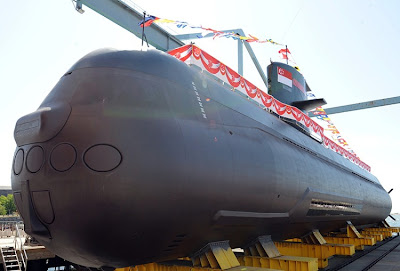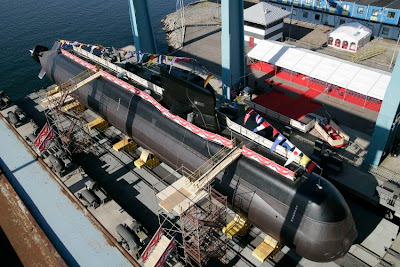 The sixth and final Formidable-class frigate, derived from the French La Fayette-class, has been delivered by DCNS and ST Marine to the Singapore navy. (US Navy photo)
DCNS Delivers the Sixth and Last Formidable-Class Frigate to the Singaporean Navy
The sixth and final Formidable-class frigate, derived from the French La Fayette-class, has been delivered by DCNS and ST Marine to the Singapore navy. (US Navy photo)
DCNS Delivers the Sixth and Last Formidable-Class Frigate to the Singaporean Navy
(Source: DCNS; dated Aug. 22, issued Aug. 26, 2008)
SINGAPORE --- DCNS, a world leader in the design and realisation of advanced naval defence systems, today announced the completion of the New Frigate Programme for the Republic of Singapore Navy (RSN), with the delivery of
RSS Supreme (73). This also marks the achievement of a comprehensive technology transfer to Singapore Technologies Marine (ST Marine) at the local shipyard providing turnkey shipbuilding.
In 2000, DCNS was awarded a contract to build six Formidable-Class Frigates as part of the New Frigate Programme, outlined by Singapore’s Ministry of Defence through the Defence and Science Technology Agency (DSTA). As part of this contract, based on its history and experience in building naval defence systems, DCNS focused on ensuring a full technology transfer to ST Marine.
The delivery of RSS Supreme (73) and the technology transfer to ST Marine underscores and cements the commitment of DCNS to enabling the Republic of Singapore Navy to become a world-class defence force. As Europe’s leading naval defence systems provider, DCNS can greatly contribute to governments in the Asia Pacific region that are looking to develop their naval defence systems to address growing security requirements.
The first frigate, RSS Formidable (68), was built at the DCNS shipyard in Lorient, France. The five following frigates were built in Singapore by ST Marine under DCNS supervision.
The completion of the technology transfer is a testimony of the strong partnership between the two companies. “ST Marine is very glad to have had DCNS as a partner in the last eight years to work on the RSN’s New Frigate Programme to replace the Missile Gun Boats. This partnership has culminated in the delivery of a fleet of highly capable frigates to the RSN", said CHANG Cheow Teck, President of ST Marine.
DCNS and ST Marine are thankful to DSTA and the RSN for their strong and continuous support throughout this successful program.
RSS Supreme (73) together with RSS Stalwart (72) are expected to be commissioned in the first quarter of 2009. The first four Formidable-Class Frigates are currently in operation and are already participating in advanced combat exercises with foreign navies, abroad. The 3,200 -tonne, 114 -metre long Formidable-Class Frigates, are regarded as the Singapore navy's most powerful warships.
The design of the Singapore Formidable-class frigates is based on the French Navy’s La Fayette Class Frigate, which boasts significant anti-air, anti-surface and anti-submarine warfare capabilities. The design of the frigates also has effective stealth capabilities, which reduce visibility of the frigates on radar screens, enhancing their survivability during combat.
Formidable-class frigates are also reputed for their advanced electronic systems, capable of preventing modern network-based attacks. These features have enabled the Republic of Singapore Navy to better fulfill its mission of protecting Singapore's coastlines and safeguarding its waters.
DCNS commenced operations in Singapore in 2002 and today has a team of 40 staff based in Singapore, which will continue to provide service and support to the RSN here. Globally, DCNS has the broadest range of naval defence capabilities and services, spanning from warships to nuclear submarines.
The DCNS Group is one of Europe’s leading players on the world market for naval defence systems. To meet customer demands for more comprehensive and integrated systems, DCNS acts as prime contractor for naval shipbuilding, integration and support by combining its own development, marketing and production capabilities with those of selected partners. The DCNS Group employs 13,000 people and generates annual revenues of around EUR 2.8 billion.
ST Marine, the marine arm of ST Engineering, provides turnkey building, repair and conversion services for a wide spectrum of naval and commercial vessels. In shipbuilding, it has the proven capabilities to provide turnkey solutions from concept definition to detailed design, construction, on-board system installation and integration, testing, commissioning to through-life support.
-ends-












